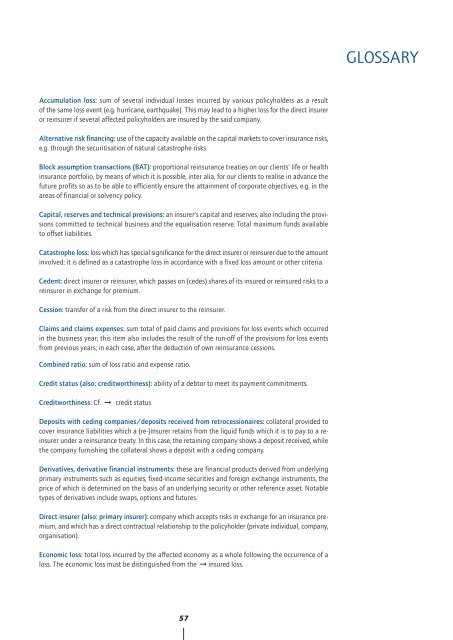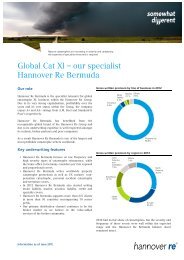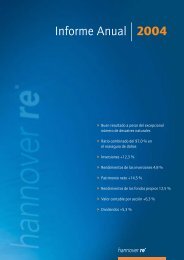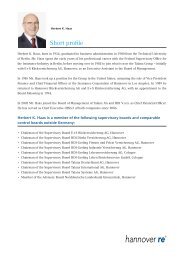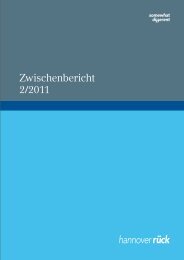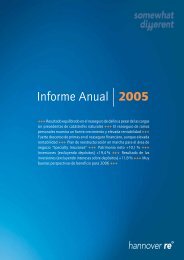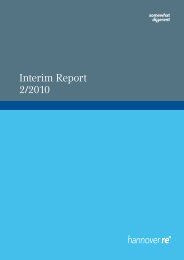Annual Report 2003 - Hannover Re
Annual Report 2003 - Hannover Re
Annual Report 2003 - Hannover Re
Create successful ePaper yourself
Turn your PDF publications into a flip-book with our unique Google optimized e-Paper software.
GLOSSARY<br />
Accumulation loss: sum of several individual losses incurred by various policyholders as a result<br />
of the same loss event (e.g. hurricane, earthquake). This may lead to a higher loss for the direct insurer<br />
or reinsurer if several affected policyholders are insured by the said company.<br />
Alternative risk financing: use of the capacity available on the capital markets to cover insurance risks,<br />
e.g. through the securitisation of natural catastrophe risks.<br />
Block assumption transactions (BAT): proportional reinsurance treaties on our clients' life or health<br />
insurance portfolio, by means of which it is possible, inter alia, for our clients to realise in advance the<br />
future profits so as to be able to efficiently ensure the attainment of corporate objectives, e.g. in the<br />
areas of financial or solvency policy.<br />
Capital, reserves and technical provisions: an insurer's capital and reserves, also including the provisions<br />
committed to technical business and the equalisation reserve. Total maximum funds available<br />
to offset liabilities.<br />
Catastrophe loss: loss which has special significance for the direct insurer or reinsurer due to the amount<br />
involved; it is defined as a catastrophe loss in accordance with a fixed loss amount or other criteria.<br />
Cedent: direct insurer or reinsurer, which passes on (cedes) shares of its insured or reinsured risks to a<br />
reinsurer in exchange for premium.<br />
Cession: transfer of a risk from the direct insurer to the reinsurer.<br />
Claims and claims expenses: sum total of paid claims and provisions for loss events which occurred<br />
in the business year; this item also includes the result of the run-off of the provisions for loss events<br />
from previous years; in each case, after the deduction of own reinsurance cessions.<br />
Combined ratio: sum of loss ratio and expense ratio.<br />
Credit status (also: creditworthiness): ability of a debtor to meet its payment commitments.<br />
Creditworthiness: Cf. ➞ credit status<br />
Deposits with ceding companies/deposits received from retrocessionaires: collateral provided to<br />
cover insurance liabilities which a (re-)insurer retains from the liquid funds which it is to pay to a reinsurer<br />
under a reinsurance treaty. In this case, the retaining company shows a deposit received, while<br />
the company furnishing the collateral shows a deposit with a ceding company.<br />
Derivatives, derivative financial instruments: these are financial products derived from underlying<br />
primary instruments such as equities, fixed-income securities and foreign exchange instruments, the<br />
price of which is determined on the basis of an underlying security or other reference asset. Notable<br />
types of derivatives include swaps, options and futures.<br />
Direct insurer (also: primary insurer): company which accepts risks in exchange for an insurance premium,<br />
and which has a direct contractual relationship to the policyholder (private individual, company,<br />
organisation).<br />
Economic loss: total loss incurred by the affected economy as a whole following the occurrence of a<br />
loss. The economic loss must be distinguished from the ➞ insured loss.<br />
57


